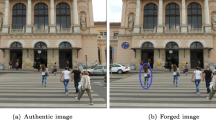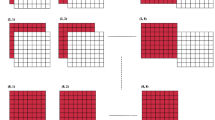Abstract
Quantization artifact and blocking artifact are the two types of well-known fingerprints of JPEG compression. Most JPEG forensic techniques are focused on these fingerprints. However, recent research shows that these fingerprints can be intentionally concealed via anti-forensics, which in turn makes current JPEG forensic methods vulnerable. A typical JPEG anti-forensic method is adding anti-forensic dither to DCT transform coefficients and erasing blocking artifact to remove the trace of compression history. To deal with this challenge in JPEG forensics, in this paper, we propose a novel countering method based on the noise level estimation to identify the uncompressed images from those forged ones. The experimental results show that the proposed method achieves superior performance on several image databases with only one-dimensional feature. It is also worth emphasizing that the proposed threshold-based method has explicit physical meaning and is simple to be implemented in practice. Moreover, we analyze the strategies available to the investigator and the forger in the case of that they are aware of the existence of each other. Game theory is used to evaluate the ultimate performance when both sides adopt their Nash equilibrium strategies.
Similar content being viewed by others
References
Kwok C W, Au O C, Chui S H. Alternative anti-forensics method for contrast enhancement. In: Proceedings of the 10th International Conference on Digital-Forensics and Watermarking, Atlantic, 2011. 398–410
Milani S, Tagliasacchi M, Tubaro S. Antiforensics attacks to Benford’s law for the detection of double compressed images. In: Proceedings of International Conference on Acoustics, Speech, and Signal Processing, Vancouver, 2013. 3053–3057
Qian Z X, Zhang X P. Improved anti-forensics of JPEG compression. J Syst Softw, 2014, 91: 100–108
Fan W, Wang K, Cayre F, et al. JPEG anti-forensics using non-parametric DCT quantization noise estimation and natural image statistics. In: Proceedings of the 1st ACM Workshop on Information Hiding and Multimedia Security, Montpellier, 2013. 117–122
Barni M, Tondi B. The source identification game: an information-theoretic perspective. IEEE Trans Inf Forens Secur, 2013, 8: 450–463
Stamm M C, Lin W S, Liu K J R. Forensics vs. anti-forensics: a decision and game theoretic framework. In: Proceedings of International Conference on Acoustics, Speech, and Signal Processing, Kyoto, 2012. 1749–1752
Pevny T, Fridrich J. Detection of double-compression in JPEG images for applications in steganography. IEEE Trans Inf Forens Secur, 2008, 3: 247–258
Lukas J, Fridrich J. Estimation of primary quantization matrix in double compressed JPEG images. In: Proceedings of Digital Forensic Research Workshop, Cleveland, 2003. 1–17
Fu D D, Shi Y Q, Su W. A generalized Benford’s law for JPEG coefficients and its applications in image forensics. In: Proceedings of SPIE 6505, Security, Steganography, and Watermarking of Multimedia Contents, San Jose, 2007. 65051L
He J F, Lin Z C, Wang L F, et al. Detecting doctored JPEG images via DCT coefficient analysis. In: Proceedings of 9th European Conference on Computer Vision, Graz, 2006. 423–435
Bianchi T, de Rosa A, Piva A. Improved DCT coefficient analysis for forgery localization in JPEG images. In: Proceedings of International Conference on Acoustics, Speech, and Signal Processing, Prague, 2011. 2444–2447
Farid H. Exposing digital forgeries from JPEG ghosts. IEEE Trans Inf Forens Secur, 2009, 4: 154–160
Farid H. Digital Image Ballistics from JPEG Quantization. TR2006–583. 2008
Stamm M C, Tjoa S K, Lin W S, et al. Anti-forensics of JPEG compression. In: Proceedings of IEEE International Conference on Acoustics, Speech and Signal Processing, Dallas, 2010. 1694–1697
Stamm M C, Liu K J R. Anti-forensics of digital image compression. IEEE Trans Inf Forens Secur, 2011, 6: 1050–1065
Jiang Y W, Zeng H, Kang X G, et al. The game of countering JPEG anti-forensics based on the noise level estimation. In: Proceedings of Asian-Pacific Signal and Information Processing Association Annual Submit Conference, Taiwan, 2013. 1–9
Schaefer G, Stich M. UCID: an uncompressed color image database. In: Proceedings of SPIE 5307, Storage and Retrieval Methods and Applications for Multimedia, San Jose, 2004. 472–480
Bas P, Filler T, Pevny T. Break our steganographic system: the ins and outs of organizing BOSS. In: Proceedings of International Conference on Information Hiding, Prague, 2011. 59–70
Lam E Y, Goodman J W. A mathematical analysis of the DCT coefficient distributions for images. IEEE Trans Image Process, 2000, 9: 1661–1666
Fan Z G, de Queiroz R L. Identification of bitmap compression history: JPEG detection and quantizer estimation. IEEE Trans Image Process, 2003, 12: 230–235
Kirchner M, Fridrich J. On detection of median filtering in digital images. In: Proceedings of SPIE, Electronic Imaging, Media Forensics and Security II, San Jose, 2010. 1–12
Lai S Y, Bohme R. Countering counter-forensics: the case of JPEG compression. In: Proceedings of International Conference on Information Hiding, Prague, 2011. 285–298
Valenzise G, Nobile V, Tagliasacchi M, et al. Countering JPEG anti-forensics. In: Proceedings of IEEE International Conference on Image Processing, Brussels, 2011. 1949–1952
Valenzise G, Tagliasacchi M, Tubaro S. Revealing the traces of JPEG compression anti-forensics. IEEE Trans Inf Forens Secur, 2013, 8: 335–349
Rudin L I, Osher S, Fatemi E. Nonlinear total variation based noise removal algorithms. Physica D: Nonl Phenom, 1992, 60: 259–268
Li H D, Luo W Q, Huang J W. Countering anti-JPEG compression forensics. In: Proceedings of IEEE International Conference on Image Processing, Orlando, 2012. 241–244
Liu X H, Tanaka M, Okutomi M. Noise level estimation using weak textured patches of a single noisy image. In: Proceedings of IEEE International Conference on Image Processing, Orlando, 2012. 665–668
Shin D H, Park R H, Yang S, et al. Block-based noise estimation using adaptive Gaussian filtering. IEEE Trans Consum Electr, 2005, 51: 218–226
Pyatykh S, Hesser J, Zheng L. Image noise level estimation by principal component analysis. IEEE Trans Image Process, 2013, 22: 687–699
Liu W, Lin W S. Additive white Gaussian noise level estimation in SVD domain for images. IEEE Trans Image Process, 2013, 22: 872–883
Lyu S W, Pan X Y, Zhang X. Exposing region splicing forgeries with blind local noise estimation. Int J Comput Vis, 2014, 110: 202–221
Osborne M J, Rubinstein A. A Course in Game Theory. Cambridge: MIT Press. 1994
Hespanha J P. An Introductory Course in Noncooperative Game Theory. http://www.ece.ucsb. edu/~hespanha/
Grant M C, Boyd S P. Graph Implementations for Non-smooth Convex Programs. Recent Advances in Learning and Control. Heidelberg: Springer-Verlag, 2008. 95–110
Acknowledgements
This work was supported by National Natural Science Foundation of China (Grant Nos. U1536204, 61379155, 61332012), National Natural Science Foundation of Guangdong Province (Grant No. s2013020012788), and Special Funding for Basic Scientific Research of Sun Yat-sen University (Grant No. 6177060230).
Author information
Authors and Affiliations
Corresponding author
Rights and permissions
About this article
Cite this article
Zeng, H., Yu, J., Kang, X. et al. Countering JPEG anti-forensics based on noise level estimation. Sci. China Inf. Sci. 61, 032103 (2018). https://doi.org/10.1007/s11432-016-0426-1
Received:
Revised:
Accepted:
Published:
DOI: https://doi.org/10.1007/s11432-016-0426-1




